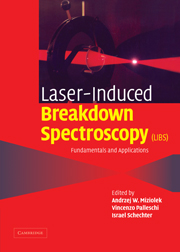Book contents
- Frontmatter
- Contents
- List of contributors
- Preface
- 1 History and fundamentals of LIBS
- 2 Plasma morphology
- 3 From sample to signal in laser-induced breakdown spectroscopy: a complex route to quantitative analysis
- 4 Laser-induced breakdown in gases: experiments and simulation
- 5 Analysis of aerosols by LIBS
- 6 Chemical imaging of surfaces using LIBS
- 7 Biomedical applications of LIBS
- 8 LIBS for the analysis of pharmaceutical materials
- 9 Cultural heritage applications of LIBS
- 10 Civilian and military environmental contamination studies using LIBS
- 11 Industrial applications of LIBS
- 12 Resonance-enhanced LIBS
- 13 Short-pulse LIBS: fundamentals and applications
- 14 High-speed, high-resolution LIBS using diode-pumped solid-state lasers
- 15 Laser-induced breakdown spectroscopy using sequential laser pulses
- 16 Micro LIBS technique
- 17 New spectral detectors for LIBS
- 18 Spark-induced breakdown spectroscopy: a description of an electrically generated LIBS-like process for elemental analysis of airborne particulates and solid samples
- Index
- References
13 - Short-pulse LIBS: fundamentals and applications
Published online by Cambridge University Press: 08 August 2009
- Frontmatter
- Contents
- List of contributors
- Preface
- 1 History and fundamentals of LIBS
- 2 Plasma morphology
- 3 From sample to signal in laser-induced breakdown spectroscopy: a complex route to quantitative analysis
- 4 Laser-induced breakdown in gases: experiments and simulation
- 5 Analysis of aerosols by LIBS
- 6 Chemical imaging of surfaces using LIBS
- 7 Biomedical applications of LIBS
- 8 LIBS for the analysis of pharmaceutical materials
- 9 Cultural heritage applications of LIBS
- 10 Civilian and military environmental contamination studies using LIBS
- 11 Industrial applications of LIBS
- 12 Resonance-enhanced LIBS
- 13 Short-pulse LIBS: fundamentals and applications
- 14 High-speed, high-resolution LIBS using diode-pumped solid-state lasers
- 15 Laser-induced breakdown spectroscopy using sequential laser pulses
- 16 Micro LIBS technique
- 17 New spectral detectors for LIBS
- 18 Spark-induced breakdown spectroscopy: a description of an electrically generated LIBS-like process for elemental analysis of airborne particulates and solid samples
- Index
- References
Summary
Introduction
The basis of laser-induced breakdown spectroscopy (LIBS) is well established – real time, simultaneous multielement chemical analysis without sample preparation. Although the advantages are well recognized, understanding the fundamental laser ablation processes underlying this technology remains a quest. The heart of LIBS is the luminous plasma; its initiation and history are critical to applications. The plasmas' properties depend on experimental parameters, including the laser pulse (energy, duration, repetition rate, and wavelength), the sample (physical and optical), and ambient atmosphere (gas, pressure). Except for a few research papers in the analytical literature, most LIBS applications are based on nanosecond pulsed lasers. There are two compelling reasons to delve into the short-pulse regime for LIBS – expected differences in the laser–material and the laser–plasma interactions. Stated differently, there is reason to believe that improved analytical accuracy, precision, and sensitivity can be achieved by the use of short-pulsed lasers for LIBS applications.
In the LIBS plasma, spectral emission intensity of elemental lines is based on the amount of mass ablated as well as on the concentration of that mass in the sample (ignoring plasma temperature and electron number density for the moment). For accurate chemical analysis, the chemistry of the ablated mass must be representative of the sample (no fractionation). Ideally, there also would be matrix independence; the same amount of mass would be ablated independent of sample properties. These two goals can be realized by better understanding and controlling the laser–material interaction. Finally, the plasma itself can influence the ablation process.
- Type
- Chapter
- Information
- Laser Induced Breakdown Spectroscopy , pp. 477 - 489Publisher: Cambridge University PressPrint publication year: 2006



